If you’re looking for a way to add a bit of texture and sparkle to your needlework, how about a bit of bead embroidery? There are many hand embroidery stitches that can be used in conjunction with beads, to create textured lines or fillings. One of my favorites is the Palestrina stitch.
The Palestrina stitch is already a textured stitch, as it forms a string of nice, fat knots along the line of stitching. It’s a magnificent stitch for creating a textured line, and once you get the rhythm of the stitch, it’s an easy and fun stitch to work! It’s the same stitch used in twilling, a stitching technique popular among quilters in the Midwest, which is essentially embroidering blocks using Palestrina stitch.
In today’s Stitch Play, we’re going to add some beads to Palestrina Stitch.
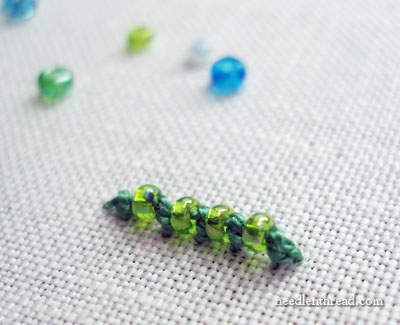
Beaded Palestrina stitch will result in a line that looks something like the little nubby line above: a string of knots, each knot alternating with a bead. I’m using a #12 perle cotton, and the beads come from some vial of beads out of my stash – they weren’t numbered with a specific size or anything. They’re just craft beads. The only criteria I was looking for when I selected them is that they had holes large enough to accommodate my thread.
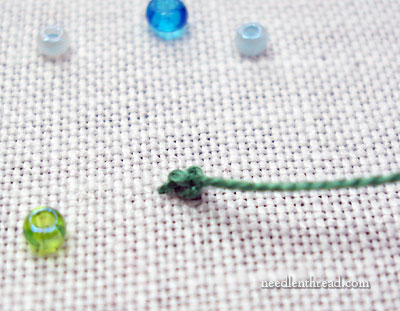
The concept is simple: start your line of stitching with one Palestrina stitch knot. If you aren’t sure how to work the Palestrina stitch, you can take a look at my Palestrina Stitch video.
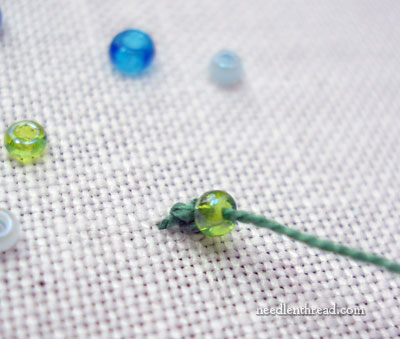
After the knot, add a bead!
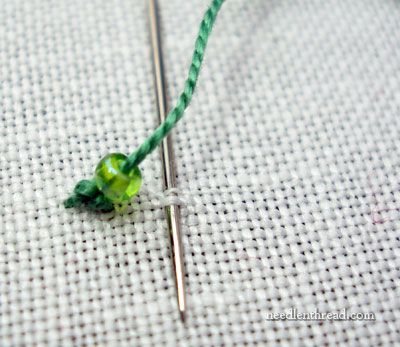
Start your next Palestrina stitch knot after the bead, not too close to cram the knot against the bead, but close enough to encase the bead between the two knots. If the knots are too close to the beads, the line will buckle. So leave the beads enough space, but not too much to make the line look stringy.
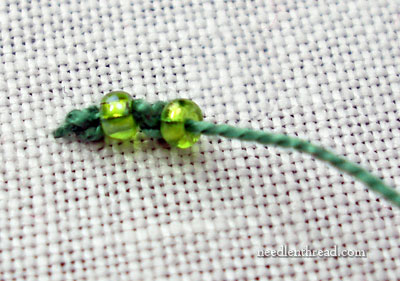
You might have to play a bit with the spacing, until you’re comfortable with the results. A “doodle cloth” is a great place to do this! A “doodle cloth” is a piece of scrap fabric, hooped up and ready to stitch on, that you keep in your work basket so that you can work out problematic stitches. It’s always nice to have one set up, on hand.
The spacing between the beads and stitches won’t take much to figure out – play with it once, and you’ll get it!
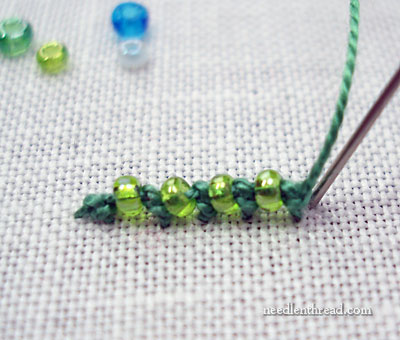
End the line of beaded Palestrina stitch with a Palestrina stitch knot, and take the needle down into the fabric directly after the last knot. And that’s it!
You can work this technique on straight lines or on curves, and I think you’ll find it’s really pretty! You can also mix about your thread and bead colors, too.

And, of course, you can use it for bug bodies. Doesn’t that look like a caterpillar?
This post is part of a new series here on Needle ‘n Thread called Stitch Play, where we fiddle around a bit with hand embroidery stitches. If you’d like to see me fiddle about with any stitch or technique in particular in this series, or if you have a specific difficulty with any embroidery stitch, feel free to leave a comment below, and I’ll work up something for you!







G’day Mary,
This would be lovely on crazy patchwork seams, Christmas trees using different coloured beads for baubles and around the hem of a little girls skirt with a hairband to match, or even decorating knitwear and bags.
Yes, and a very fine creepy crawly too. In an appropriate colour and length, it would also make an awesome snake who took a short cut through a golf course! Albeit, a rough passage through, which ever way you look at it!
Thanks Mary, Cheers, Kath.
I love this new series, it’s so helpful and inspiring. And I think that beads make almost any embroidery better. I can definitely see this in white floss with gold beads for Christmas.
Excellent! So much fun — I will have to try this.
Dear Mary
Wbat a good idea I’m going to stitch beads on the second part of the pomegranate project so this stitch will come in handy, thanks
I’d love a demonstration of the whipped stem stitch which you stitched on the sheeps fur on the Angus Dei symbol.
Thanks
Regards Anita Simmance
I love the look of this stitch enhanced with beads. It’s not intimidating or complicated to do and will certainly add a lot of pizzazz to embroidery projects! Thanks, Mary!
I like that stitch, however, doing my beading with polyfilament can’t be accomplished with seed beads, which is what I mostly use on my creatures.
How neat would this stitch look in size 16 pearl cotton and tiny pearls on the edge of a wedding veil!!
I’m currently beading a wedding veil… adding clear sequins and crystal beads to a “roses” lace on the edge of a mantilla. But I can see this on the edge of a plain veil, instead of a satin cord or added to a tiny rolled edge. I’ve more veils to create (more nieces are getting married soon) so I hope to give it a try.
What a fantastic idea – and what lucky neices.
Mary,
You are wonderful! Thank you so much for this Palestrina stitch combining thread and beads. I have been searching for something to put on the top of a pin cushion and today I found it in your newsletter! Bless you!
Karen
Mary –
I have so been enjoying all of the new stitches you have been putting up in the last days and weeks and this one is another winner! I also loved the combination of chain and buttonhole. Thanks so much for all of the inspiration. Anastasia
I wish you would sell all your videos on dvd’s. We do not have Internett up in our mountain cabin!!!!
Speaking of doodling, can you please play with your French knots so I can figure out why sometimes mine don’t look like knots and other times they are beautiful. I think FR. Knots are the hardest stitch in the whole stitching kingdom and yet they are used all of the time. Thanks.
I agree with Kath, what a cute way to decorate edges of shirt sleeves or bobby socks or a crazy quilt. I’m thinking of trying new stitches on a doodle cloth and then using that cloth as a quilt block once it gets full. If anyone has a full doodle they want to donate, I wouldn’t turn down a donation or two!
LOL I was thinking “that would be great to illustrate the song ‘Inch Worm'”
I love the Stitch Play series! So helpful. Thanks for your work and providing us with something beautiful and inspiring every day!
Oh, I like this. It could be used with any knotted stitch, like coral stitch and scroll stitch, couldn’t it? I think so. I think I’m going to go try it right now.
Love the Palestrina stitch idea, and thanks for making so much available – a great help and inspiration!
Love, love you site. Just discovered it. Incredible amount of wonderful info. Thank you! Love stitch play.
Mary, I wish you’d write a book that looks just like these tutorials. You write such easy-to-understand directions, which isn’t true of all embroidery books. I would love to have these in a book to tuck into my tote…just dreaming!! Thank you.
beautiful
I would like to find more stitches that use beads like this one. Do you have suggests on how to find them.
–Caren
I just want to say thank you for making clear and concise video tutorials showing your embroidery stitches.. Sometimes pictures just aren’t enough! Your work is beautiful, and I can only aspire to be as good as you some day. Thank you again. Lynn
Palestrina is my favourite too. Haven’t tried it with beads – a new experience. Thank you.
very nice
Hi Mary,
Great site and easy to understand tutorial. I am ready for some designs to work on, but do not see anything out to buy. Any suggestions for a book with traceable patterns? Thank you,
Arlene
Hi, Darlene – glad you liked the tutorial! Well, the Lavender Honey and other Little Things are proving to be pretty popular: https://needlenthread.wpengine.com/2013/07/lavender-honey-other-little-things-its-out.html They’re a lot of fun!
-MC
Thanks you for this! Letting my imagination out of the box now!
Love it!
Thank You, enjoyed the instructions
Thank you very much sharing your knowledge and expertise. You are truly inspirational.
I have a hard time with bullion knots and would love to see more on those, thanks! : )
I am making the Peace Angels quilt wall hanging and want beautiful hair. The Palestrina stitch and beads is perfect